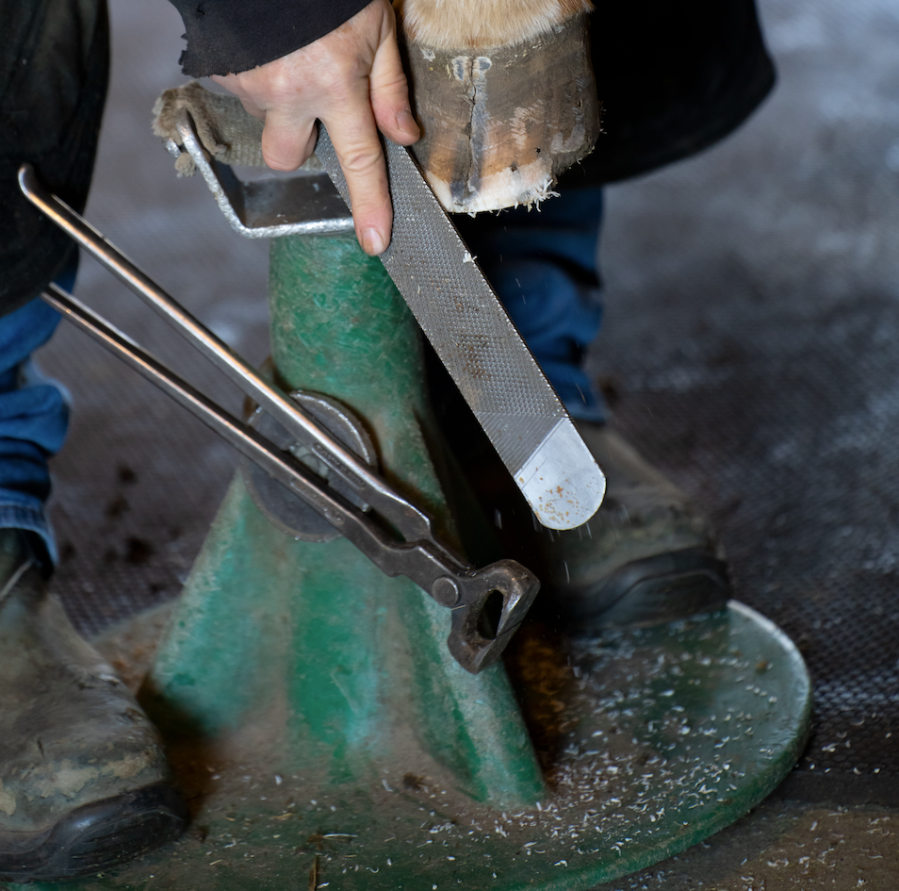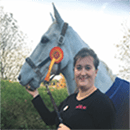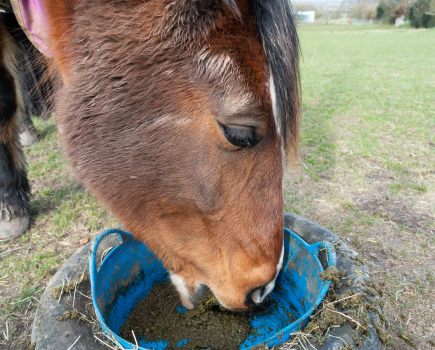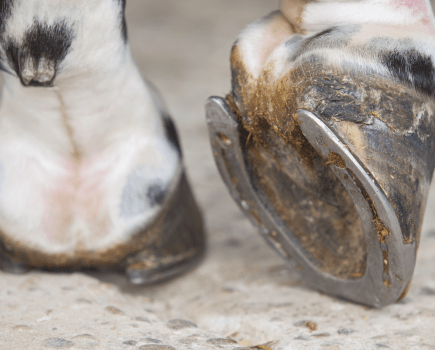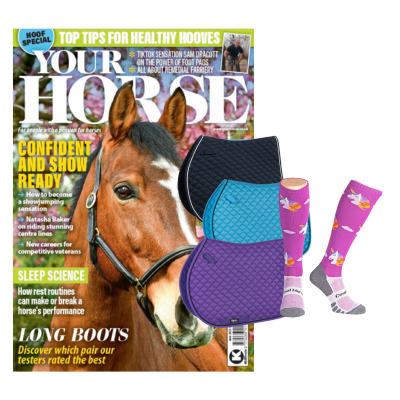Without regular trimming, a horse’s hooves will continue to grow, eventually becoming so long that each hoof curls at the toe.
In the wild, horses are constantly on the move and cover varying terrain, which causes hooves to wear down and naturally keeps them short. However, domesticated horses don’t live or work in the same way.
Regularly trimmed hooves are stronger and healthier, whether they wear shoes or are unshod. Horses with routine farrier visits are more likely to stay sound for longer, which is why trimming is such a vital part of good hoof care.
Hoof trimming: how it’s done
Before the farrier arrives, make sure your horse’s hooves are clean and dry. This applies to the whole leg, so that they don’t have to hold wet, muddy legs.
The trimming process is:
- The farrier will pick up the horse’s leg and hold it between their knees, so that it is held firmly and they can see the sole. It’s important that in between farrier visits you routinely lift and handle your horse’s legs, so that they are confident when being trimmed or shod and will quietly stand still, sometimes for a long time.
- The first thing the farrier will do is clean the hoof. They will use a hoof knife to do this and you may start to see clean sole (white) as the dirty black layer is removed. This applies to the ridges on either side of the frog too — a hoof knife has a specially curved end to help clean these areas. Once finised with the hoof knife, the farrier will use a wire brush to get rid of dust and dirt.
- Using sharp hoof nippers (which look a little bit like pliers), the farrier will cut excess hoof wall from around the full circumference of the hoof. Some horses will need more trimmed than others. It’s a bit like a person trimming their nails — and it’s the trimmed hoof that you’ll see on the floor afterwards. (Dogs often like to pick these up!)
- Next, the farrier will use a rasp to smooth out any sharp edges left by the hoof nippers.
- It may be necessary for the farrier to remove any excess sole and frog. They are trained to know what is live sole, exfoliating sole, and retained sole — live sole should not be trimmed and will cause the horse pain if done so.
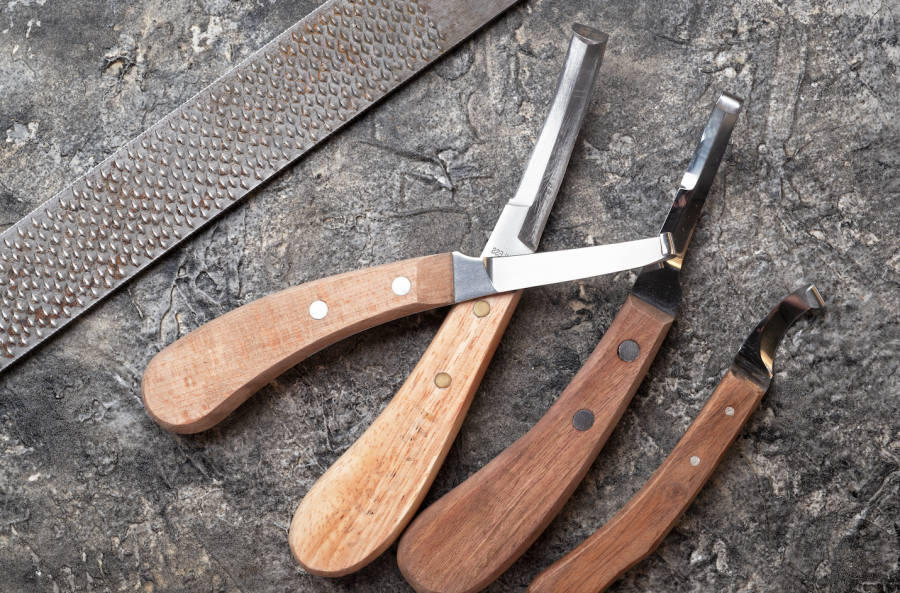
Hoof anatomy
A horse’s hoof is a lot more than what see on the outside. These are the three areas that you can see:
Hoof wall
The hoof wall is the outer layer of the hoof and it is made of keratin, like human fingernails. It is hard and either black or white. It is the hoof wall that will grow and grow without trimming, providing it is strong and healthy. Potential problems include cracking and brittleness.
Sole of the hoof
On the bottom of the hoof is the sole, which you see when you pick out debris your horse’s feet with a hoof pick. It is the job of the sole and the hoof wall to protect the inner hoof capsule and bones.
The sole is softer than the hoof wall and problems can occur if it is allowed to become wet and soften even more, leaving the horse vulnerable to problems such as thrush, bruising and abscesses caused by puncture wounds.
The frog
The frog is the ‘V’ you see in the sole of your horse’s foot. It runs from the heel bulbs of the hoof towards the toe and it is a sensitive area. It plays an important role in helping blood to pump to the heart.
Hoof trimming for healthy hooves
When hoof trimming is complete, ask your farrier how healthy they think the hooves are and whether they recommend anything to improve them. Some, for example, may recommend applying an ointment to help with their condition and prevent them becoming brittle.
Remember it’s important to keep your horse’s farrier appointments whether your horse is shod or barefoot. Overgrown hooves cause horses, ponies, donkeys and all equines pain, affect hoof balance and in some cases, particularly welfare cases, prevent the animal from walking properly.
Trimming a barefoot hoof
Horses who are barefoot and ridden regularly will wear hooves down, some more than others. Regular visits from a farrier are still essential, though, ideally every four to six weeks.
Even if hoof trimming isn’t required at every visit, a farrier will be able to assess hoof length, condition and could even spot any potential problems before they become an issue.
What is an equine podiatrist?
In the UK, hoof trimming can be done by an equine podiatrist as well as a farrier — but it’s important to understand what the difference is between the two.
Only a registered farrier can put shoes on a horse in the UK. For our international readers, check your country’s regulations so that you do right by your equine.
Equine podiatrists are specialists in barefoot hoof care. They are able to provide trimming and general barefoot advice, but must not fix a shoe of any kind to a horse’s hoof.
Trimming of a hoof that is not going to have a shoe put on is not covered by the Farriers Registration Act UK, which means it is not imperative that a farrier does it.
According to its website, the Equine Podiatry Association UK (EPA) was launched in April 2006 “as a self-regulating professional body” for its members practicing in the UK.
Members are required to hold a relevant qualification in barefoot hoof care and update their skills through training every year.
Before employing the services of an equine podiatrist, make sure they are a member of the Equine Podiatry Association UK.
All images © Shutterstock

